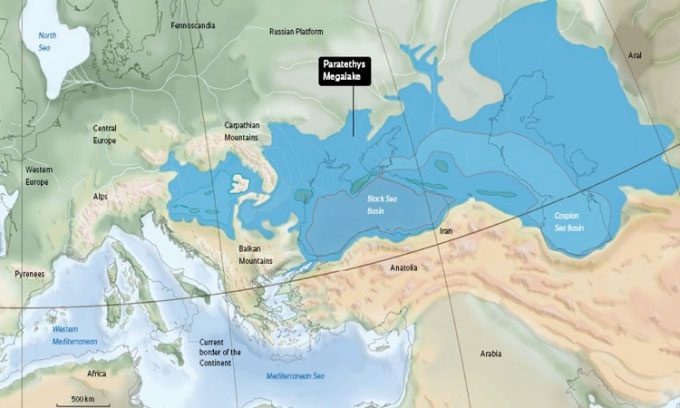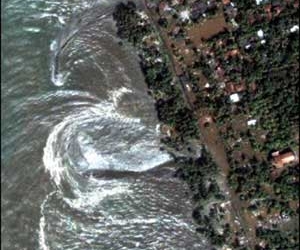Existing about 34 million years ago, Paratethys was the largest lake ever to exist on Earth.
The Paratethys Sea was located on the continental shelf, stretching from present-day Austria to Turkmenistan, along the southern edge of the Eurasian continent, covering an area of 2.8 million km2, according to IFL Science. This marine region formed through the uplift of mountain ranges in the Alps and Carpathians, leading to the creation of a basin connected to the Mediterranean Sea to the south. However, around 12 million years ago, a collision between the African and European tectonic plates sealed off this connection. As a result, Paratethys was reclassified as a lake.

The Paratethys Sea was the largest superlake ever to exist on Earth. (Image: Wikipedia).
Paratethys contained 1.77 million km3 of water, more than ten times the total volume of all current lakes combined. Although it had a larger surface area than the Mediterranean Sea, Paratethys was much shallower, meaning its water volume was only about half that of the Mediterranean Sea (3.75 million km3).
While the Mediterranean Sea once contained freshwater flowing in from many rivers across continental Europe, Paratethys blocked this supply. Instead, all freshwater flowed into the lake. Consequently, the flora and fauna in the region changed from diverse marine species to less rich freshwater organisms. The enormous size of Paratethys significantly influenced the climate of the Eurasian continent. The moisture generated by the lake contributed to reducing temperature differences between seasons, promoting a more stable climate.
However, Paratethys did not last long due to a period of “extreme aridity” that led to very low rainfall on the Eurasian continent. Water in the lake evaporated without being replenished by rain. During a period known as the Great Khersonian Drying, between 7.7 and 9.8 million years ago, the lake’s water level dropped by approximately 250 meters. Paratethys lost about 70% of its surface area and 30% of its volume, reducing it to the size of the present-day Black Sea. The drying process also impacted the local ecosystem. Dolphins, seals, and even the smallest whale species in the world (Cetotherium riabinini), which once lived in Paratethys, could not survive in the shrinking water environment.
Species reliant on the lake water were forced to leave the area. Many migrated to the African plains. Some evolved into the giraffes and elephants we see today. The shrinkage of the lake also affected the climate of the Eurasian continent, paving the way for colder winters and hotter summers.
As Paratethys continued to shrink, it formed three distinct regions that still exist today. The Black Sea, located in Eastern Europe and Western Asia, covers 430,000 km2. The Caspian Sea is currently the largest lake in the world, covering 371,000 km2 in the Middle East. Finally, the Aral Sea has an area of 68,000 km2 but is shrinking due to drought conditions caused by human activities.





















































